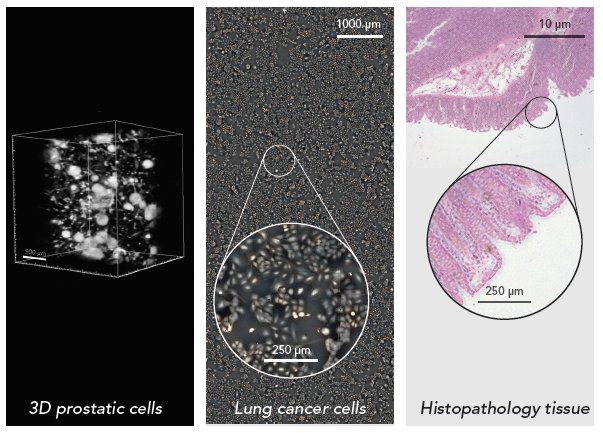A Imaging technology for point-of-care analysis and pathology screening
 What is Lensfree?
What is Lensfree?
Thanks to its extra-wide field of view and compact footprint, CEA-Leti’s lensfree imaging allows healthcare professionals to perform point-ofcare tests that previously were done in the lab. In addition, the technology is more than 10 times less expensive than an optical microscope and can image up to 10,000 microscopic biological objects at a time. This innovation is protected by 25 patents.
 How does it work?
How does it work?
The near-infrared light emitted by a LED is diffracted by the biological object being analyzed to generate a holographic pattern that is captured by a CMOS image sensor. Holographic reconstruction algorithms digitally recreate the image of the object on a display. Artificial intelligence software can then detect, analyze, and even classify biological objects by tracking metrics of interest. All of these steps are automated and, therefore, non-operator-dependent.
 Lensfree @CES2020
Lensfree @CES2020
Test the power of lensfree imaging to count and identify a variety of biological objects. Move the slide under the lensfree microscope and see the image being digitally reconstructed in real time by the microscope’s powerful algorithms. Watch as the embedded AI algorithms count and classify the objects being observed (eukaryotic cells, sperms, colon or lung tissues, plankton, neurons, etc.) in real time.
 Applications
Applications
Point-of-care testing:
The technique, using only generic hardware, can be adapted to different medical diagnostics by developing specific data processing chains for tests like:
- Complete Blood Count (developed in partnership with Horiba)
- Meningitis screening from spinal fluid (developed in partnership with Marseille-Méditerranée University Medical Center)
- Blood coagulation test (developed in partnership with startup Avalun)
Other healthcare applications:
- Monitoring of bioprocesses in bioreactors for the pharmaceutical industry: cell counts, cell viability (developed in partnership with startup Iprasense)
- 2D imaging for standard biological research and drug screening: cell counts, motility, viability, dry mass, cell-cycle duration, etc.

|
 What's new?
What's new?
Compact, robust, low-cost, automated system suitable for point-of-care analysis.
Large field of view of approximately 30 mm2 covering more than 10,000 cells per image. Multi-scale observation of the main morphological characteristics of cell tissues (> 100 μm) and cells (>5 μm) & bacteria detection (1 μm).
 Lensfree & Mobility
Lensfree & Mobility
Currently patients (or their samples) must go to medical labs for tests. In the future, lensfree imaging will bring testing labs to patients. These new compact portable labs can be used by specialist physicians in hospitals, by general practitioners in their offices, and by nurses and nurses’ aides in nursing homes or during home-care visits. Point-of-care diagnostics will help patients receive the treatment they need faster.
 What's next?
What's next?
- Further system miniaturization and development of a patient self-testing kit
-
3D microscopy for basic biological research and drug screening: spatial organization of cells, interaction of cellular and extracellular matrices at a large scale, cell migration
-
Coupling with microfluidics for organ-on-chip imaging